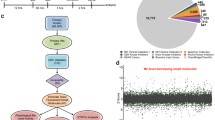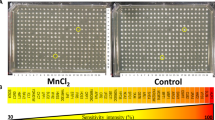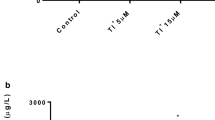Abstract
Manganese (Mn) is essential for several species and daily requirements are commonly met by an adequate diet. Mn overload may cause motor and psychiatric disturbances and may arise from an impaired or not fully developed excretion system, transporter malfunction and/or exposure to excessive levels of Mn. Therefore, deciphering processes regulating neuronal Mn homeostasis is essential to understand the mechanisms of Mn neurotoxicity. In the present study, we selected two small molecules (with opposing effects on Mn transport) from a previous high throughput screen of 40,167 to test their effects on Mn toxicity parameters in vivo using Caenorhabditis elegans. We pre-exposed worms to VU0063088 and VU0026921 for 30 min followed by co-exposure for 1 h with Mn and evaluated Mn accumulation, dopaminergic (DAergic) degeneration and worm survival. Control worms were exposed to vehicle (DMSO) and saline only. In pdat-1::GFP worms, with GFP labeled DAergic neurons, we observed a decrease of Mn-induced DAergic degeneration in the presence of both small molecules. This effect was also observed in an smf-2 knockout strain. SMF-2 is a regulator of Mn transport in the worms and this strain accumulates higher Mn levels. We did not observe improved survival in the presence of small molecules. Our results suggest that both VU0063088 and VU0026921 may modulate Mn levels in the worms through a mechanism that does not require SMF-2 and induce protection against Mn neurotoxicity.




Similar content being viewed by others
References
Aschner JL, Anderson A, Slaughter JC, Aschner M, Steele S, Beller A, Mouvery A, Furlong HM, Maitre NL (2015) Neuroimaging identifies increased manganese deposition in infants receiving parenteral nutrition. Am J Clin Nutr 102:1482–1489. https://doi.org/10.3945/ajcn.115.116285
Au C, Benedetto A, Anderson J, Labrousse A, Erikson K, Ewbank JJ, Aschner M (2009) SMF-1, SMF-2 and SMF-3 DMT1 orthologues regulate and are regulated differentially by manganese levels in C. elegans. PLoS One 4:e7792. https://doi.org/10.1371/journal.pone.0007792
Aydemir TB, Kim MH, Kim J, Colon-Perez LM, Banan G, Mareci TH, Febo M, Cousins RJ (2017) Metal transporter Zip14 (Slc39a14) deletion in mice increases manganese deposition and produces neurotoxic signatures and diminished motor activity. J Neurosci 37:5996–6006. https://doi.org/10.1523/JNEUROSCI.0285-17.2017
Benedetto A, Au C, Avila DS, Milatovic D, Aschner M (2010) Extracellular dopamine potentiates Mn-induced oxidative stress, lifespan reduction, and dopaminergic neurodegeneration in a BLI-3-dependent manner in Caenorhabditis elegans. PLoS Genet 6(8):e1001084. https://doi.org/10.1371/journal.pgen.1001084
Bornhorst J, Chakraborty S, Meyer S, Lohren H, Große Brinkhaus S, Knight AL, Caldwell KA, Caldwell GA, Karst U, Schwerdtle T, Bowman A, Aschner M (2014) The effects of pdr1, djr1.1 and pink1 loss in manganese-induced toxicity and the role of α-synuclein in C. elegans. Metallomics 6:476–490. https://doi.org/10.1039/C3MT00325F
Brenner S (1974) The genetics of Caenorhabditis elegans. Genetics 77:71–94
Chen P, Bowman AB, Mukhopadhyay S, Aschner M (2015) SLC30A10: A novel manganese transporter. Worm 4:e1042648. https://doi.org/10.1080/21624054.2015.1042648
Horning KJ, Caito SW, Tipps KG, Bowman AB, Aschner M (2015) Manganese is essential for neuronal health. Annu Rev Nutr 35:71–108. https://doi.org/10.1146/annurev-nutr-071714-034419
Jenkitkasemwong S, Akinyode A, Paulus E, Weiskirchen R, Hojyo S, Fukada T, Giraldo G, Schrier J, Garcia A, Janus C, Giasson B, Knutson MD (2018) SLC39A14 deficiency alters manganese homeostasis and excretion resulting in brain manganese accumulation and motor deficits in mice. Proc Natl Acad Sci U S A 115:E1769–E1778. https://doi.org/10.1073/pnas.1720739115
Koller WC, Lyons KE, Truly W (2004) Effect of levodopa treatment for parkinsonism in welders: a double-blind study. Neurology 62:730–733
Kumar KK, Lowe EW, Aboud AA, Neely MD, Redha R, Bauer JA, Odak M, Weaver CD, Meiler J, Aschner M, Bowman AB (2014) Cellular manganese content is developmentally regulated in human dopaminergic neurons. Sci Rep 4:6801. https://doi.org/10.1038/srep06801 http://www.nature.com/articles/srep06801 - supplementary-information
Leyva-Illades D et al (2014) SLC30A10 is a cell surface-localized manganese efflux transporter, and parkinsonism-causing mutations block its intracellular trafficking and efflux activity. J Neurosci 34:14079–14095. https://doi.org/10.1523/JNEUROSCI.2329-14.2014
Liu C, Hutchens S, Jursa T, Shawlot W, Polishchuk EV, Polishchuk RS, Dray BK, Gore AC, Aschner M, Smith DR, Mukhopadhyay S (2017) Hypothyroidism induced by loss of the manganese efflux transporter SLC30A10 may be explained by reduced thyroxine production. J Biol Chem 292:16605–16615. https://doi.org/10.1074/jbc.M117.804989
Lucchini R, Albini E, Placidi D, Gasparotti R, Pigozzi MG, Montani G, Alessio L (2000) Brain magnetic resonance imaging and manganese exposure. Neurotoxicology 21:769–775
Peres TV, Arantes LP, Miah MR, Bornhorst J, Schwerdtle T, Bowman AB, Leal RB, Aschner M (2018) Role of Caenorhabditis elegans AKT-1/2 and SGK-1 in manganese toxicity. Neurotox Res. https://doi.org/10.1007/s12640-018-9915-1
Roth JA (2006) Homeostatic and toxic mechanisms regulating manganese uptake, retention, and elimination. Biol Res 39:45–57
Sawin ER, Ranganathan R, Horvitz HR (2000) C. elegans Locomotory rate is modulated by the environment through a dopaminergic pathway and by experience through a serotonergic pathway. Neuron 26:619–631. https://doi.org/10.1016/S0896-6273(00)81199-X
Stepens A et al (2008) A Parkinsonian syndrome in methcathinone users and the role of manganese. N Engl J Med 358:1009–1017. https://doi.org/10.1056/NEJMoa072488
Sulston J, Hodgkin J (1988) Methods. Cold Spring Harbor Monograph Archive, North America, 17. Available at: https://cshmonographs.org/index.php/monographs/article/view/5032. Accessed 16 March 2018
Tuschl K, Mills PB, Parsons H, Malone M, Fowler D, Bitner-Glindzicz M, Clayton PT (2008) Hepatic cirrhosis, dystonia, polycythaemia and hypermanganesaemia--a new metabolic disorder. J Inherit Metab Dis 31:151–163. https://doi.org/10.1007/s10545-008-0813-1
Tuschl K, Clayton PT, Gospe SM Jr, Gulab S, Ibrahim S, Singhi P, Aulakh R, Ribeiro RT, Barsottini OG, Zaki MS, del Rosario ML, Dyack S, Price V, Rideout A, Gordon K, Wevers RA, “Kling” Chong WK, Mills PB (2012) Syndrome of hepatic cirrhosis, dystonia, polycythemia, and hypermanganesemia caused by mutations in SLC30A10, a manganese transporter in man. Am J Hum Genet 90:457–466. https://doi.org/10.1016/j.ajhg.2012.01.018
Wang X, Wang X, Li L, Wang D (2010) Lifespan extension in Caenorhabditis elegans by DMSO is dependent on sir-2.1 and daf-16. Biochem Biophys Res Commun 400:613–618. https://doi.org/10.1016/j.bbrc.2010.08.113
Xin Y, Gao H, Wang J, Qiang Y, Imam MU, Li Y, Wang J, Zhang R, Zhang H, Yu Y, Wang H, Luo H, Shi C, Xu Y, Hojyo S, Fukada T, Min J, Wang F (2017) Manganese transporter Slc39a14 deficiency revealed its key role in maintaining manganese homeostasis in mice. Cell Discov 3:17025. https://doi.org/10.1038/celldisc.2017.25
Zhen M, Samuel ADT (2015) C. elegans locomotion: small circuits, complex functions. Curr Opin Neurobiol 33:117–126. https://doi.org/10.1016/j.conb.2015.03.009
Acknowledgments
MA and ABB were supported by the National Institute of Health (NIH) R01 ES10563 and R01 ES07331. MA was also supported by R01 ES020852. We thank the “Deutsche Forschungsgemeinschaft” (DFG) further for the financial support of Schw 903/9-1 and BO 4103/2-1. Images were obtained at the Analytical Imaging Facility of the Albert Einstein College of Medicine [NCI cancer center support grant (P30CA013330)]. Some strains were provided by the CGC, which is funded by NIH Office of Research Infrastructure Programs (P40 OD010440). Funding agencies had no role in the study design, data collection and analysis, decision to publish, or preparation of the manuscript. In addition, we thank the members of the Vanderbilt Chemical Synthesis Core.
Author information
Authors and Affiliations
Corresponding author
Ethics declarations
Conflict of Interest
The authors declare that they have no conflict of interest.
Additional information
Highlights
This study demonstrates a potential protective role against DAergic neurodegeneration for VU0063088 and VU0026921 in Mn exposed worms.
This effect is not dependent on SMF-2, a Mn transporter.
Small molecules can be important tools to determine Mn-regulating mechanisms in vivo.
Rights and permissions
About this article
Cite this article
Peres, T.V., Horning, K.J., Bornhorst, J. et al. Small Molecule Modifiers of In Vitro Manganese Transport Alter Toxicity In Vivo. Biol Trace Elem Res 188, 127–134 (2019). https://doi.org/10.1007/s12011-018-1531-7
Received:
Accepted:
Published:
Issue Date:
DOI: https://doi.org/10.1007/s12011-018-1531-7




